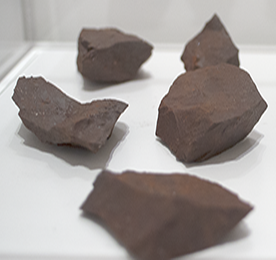Ocher
  |
- Ocher appears one ~270,000 year old European cave drawings and ~700,000 year old Asian grave sites.
- Variations in the color of ocher derive from the degree of hydration and from which other minerals are present. Reds darken with time to browns, due to acquisition of waters of hydration or a change in the oxidative state of iron.
- Hematite is a hard, brittle black mineral of ferric oxide: Fe2O3.
- If ground fine, a red ocher results that lacks any waters of hydration (anhydrous iron oxide). This makes the Venetian red pigment and the sinopia of ancient to medieval Greek and Roman times.
- Goethite is iron hydroxide (O=Fe–OH), complexed with variable numbers of waters of hydration: FeO(OH) • (H2O )n.
- Brown ochers have few waters of hydration.
- Adding waters of hydration shifts the ocher to a striking yellow color; with time, the waters are naturally lost, causing the color to return to brown.
- Ancient Phrygians, such as Kings Giordas and Midas, used abundant yellow umber to dye their fabrics, and dust from their robes would have turned all they touched to a golden color.

Yellow ocher from Roussillon.
- Ancient Phrygians, such as Kings Giordas and Midas, used abundant yellow umber to dye their fabrics, and dust from their robes would have turned all they touched to a golden color.
- Limonite is a rock that is a matrix of ferrous minerals plus various other metals.
- Manganese oxide darkens the iron hydroxides, and is present in ochers mined in Umbria and near Sienna that are a dark brown.
- Raw umber and raw sienna can be baked, driving off waters of hydration and converting iron hydroxide to iron oxide, yielding the redder burnt umber and burnt sienna.
- Magnetite (Fe3O4) is the common black ore that is resistant to rust and that can be magnetized.
- Bluing is a process that causes an iron surface to become Fe3O4 and thus become resistant to further corrosion.
- Hematite is a hard, brittle black mineral of ferric oxide: Fe2O3.
- Human uses of iron oxides:
- Body ornamentation with ocher has been widespread in time and geography; Newfoundland Native Americans greeted French explorers in ocre, lending them the term "redskins" forevermore.
- FDA #172 dye (either red, black or yellow), permitted in small quantities in sausage casings and hard and soft candies, mints and chewing gums.
- CAS 1309-37-1: cosmetic pigment for nail polish, lipstick and lotions.
These blogs were inspired by a 2017 show at the Indianapolis Museum of Art called CSI: Chemistry of Color.
